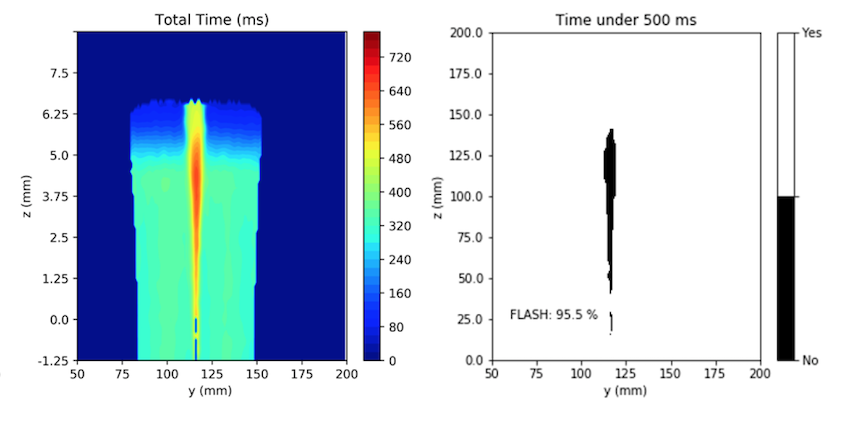FLASH Therapy*, a non-invasive, ultra-high dose rate technique delivered in less than one second, may dramatically improve the cancer-fighting benefits of therapeutic radiation by shortening treatment courses and lessening side effects.
Driven by innovation and guided by a coalition of clinical partners and FLASH thought leaders, Mevion’s Advanced Development team has developed dose rates in excess of 200 Gy/sec and has demonstrated FLASH normal tissue sparing in mortality tests on small animals. This foundational work enables Mevion to further advance and develop this potentially promising cancer treatment.
FIRST DEMONSTRATION OF FLASH EFFECT AT BRAGG PEAK
In October 2020, Mevion presented the first pre-clinical results of its research, demonstrating the FLASH effect using a commercial MEVION S250i proton accelerator.
This study:
- showed a clear signal in improved survival curves for FLASH irradiated mice;
- is the first demonstration of the FLASH effect at the Bragg Peak;
- indicated the promise of combining Bragg peak dose conformality and FLASH normal tissue sparing in one delivery system.
Watch our talk now and learn more: Mevion and FLASH Therapy
MEVION S250I - IDEAL FOR FLASH DELIVERY
Mevion proton accelerators are inherently able to achieve ultra-high dose rates and delivery speeds necessary for a successful FLASH effect thanks to its unique Direct Beam Delivery (DBD) system architecture, which features:
- highly efficient beamline: transmission efficiency is above 70% even for energies as low as 50 MeV;
- scanning magnet: 3-millisecond spot switching;
- energy modulation system: 50-milliseconds switching;
- both scanning magnet and energy modulation system are engineered with intrinsic capability for further reductions in delivery time.

Mevion Direct Beam System
Why does transmission efficiency matter?
Previous proton FLASH research has been limited by the beamline design of other proton machines that rely on conventional energy selection systems (ESS). Beamline transmission efficiencies are very low at low energy (often less than 1% at energies below 70 MeV), making it difficult to achieve a high dose rate at low energies. Experimental treatments are therefore delivered with high-energy "shoot-through" beams, resulting in uniform depth-dose distributions and abandoning the conformality advantages of the proton Bragg peak.
The core strengths of DBD allow Mevion systems to deliver both conformality and FLASH dose sparing, which are critical for clinical FLASH proton therapy treatments.
Learn more about MEVION S250i Proton Therapy System.

Mevion Direct Beam System
Why does transmission efficiency matter?
Previous proton FLASH research has been limited by the beamline design of other proton machines that rely on conventional energy selection systems (ESS). Beamline transmission efficiencies are very low at low energy (often less than 1% at energies below 70 MeV), making it difficult to achieve a high dose rate at low energies. Experimental treatments are therefore delivered with high-energy "shoot-through" beams, resulting in uniform depth-dose distributions and abandoning the conformality advantages of the proton Bragg peak.
The core strengths of DBD allow Mevion systems to deliver both conformality and FLASH dose sparing, which are critical for clinical FLASH proton therapy treatments.
Learn more about MEVION S250i Proton Therapy System.
FLASH DELIVERY TECHNIQUE FOR LARGE VOLUMES
Mevion is actively exploring techniques to deliver FLASH dose rates to a larger volume of several hundred cubic centimeters or more, a common irradiation volume for typical cancer patients.

Mevion has approached this research with Monte Carlo modeling and is pursuing additional machine development to demonstrate that adjacent intensity-modulated small volumes can be delivered at FLASH dose rates separately. Those individual small volumes can then be combined to create a single large volume1, that will benefit from FLASH normal tissue sparing. This technique offers the possibility to combine both IMPT and FLASH in one delivery system.
Reference: 1. Evans, Tucker, et al. “Time-dependent dose calculation for FLASH treatment planning.” Poster at PTCOG 2020

Mevion has approached this research with Monte Carlo modeling and is pursuing additional machine development to demonstrate that adjacent intensity-modulated small volumes can be delivered at FLASH dose rates separately. Those individual small volumes can then be combined to create a single large volume1, that will benefit from FLASH normal tissue sparing. This technique offers the possibility to combine both IMPT and FLASH in one delivery system.
Reference: 1. Evans, Tucker, et al. “Time-dependent dose calculation for FLASH treatment planning.” Poster at PTCOG 2020
FLASH DEVELOPMENT MODE
Built for power and speed, Mevion proton systems were designed with the future in mind.
MEVION S250i accelerators can be easily switched from clinical use to FLASH Development Mode to deliver the high dose rates needed for the Bragg Peak's FLASH effect at any energy, making it simpler for centers to study this breakthrough technology's potential clinical application.
The nature of the MEVION S250i synchrocyclotron allows a very high instantaneous dose rate within a pulse. Since 2019, Mevion has collaborated with scientists from Siteman Cancer Center at Barnes Jewish Hospital and Washington University in St. Louis on a series of tests on a MEVION S250i production system. The team successfully delivered over 200Gy/s dose rate and published a joint research paper in Medical Physics in 2020. This active collaboration is focusing on dose rate, dosimetry, and calibration.
MEVION FLASH RESOURCES
*FLASH Therapy is currently under preclinical research and is not yet available for commercial sale or clinical use.
